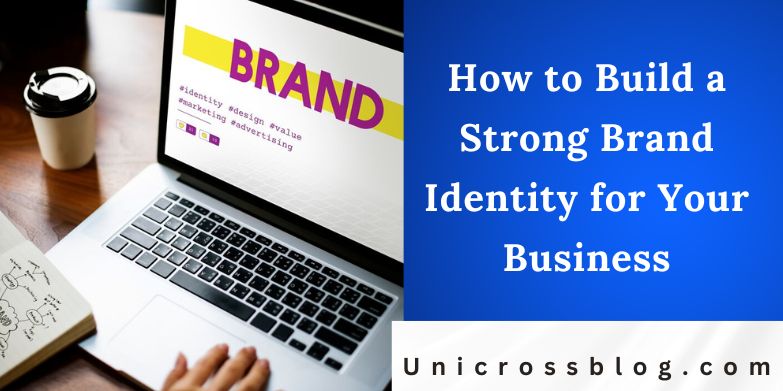A strong brand identity is the cornerstone of any successful business. It’s more than just a logo or a catchy tagline it’s the essence of who your business is, what it stands for, and how it’s perceived by your audience. A well-crafted brand identity builds trust, fosters loyalty, and sets you apart in a competitive market. Whether you’re a startup or an established company, creating a cohesive and memorable brand identity is crucial for long-term success.

Steps to Build a Strong Brand Identity
1. Define Your Brand’s Purpose and Values
Your brand identity starts with a clear understanding of your business’s purpose and core values. Ask yourself: Why does your business exist? What problems are you solving? What principles guide your decisions? Your purpose and values shape how customers perceive you and form the foundation of your brand.
-
Actionable Tip: Write a mission statement that captures your purpose. For example, a coffee shop might state, “To create a welcoming space where everyone enjoys ethically sourced coffee.” Identify 3–5 core values, such as sustainability, quality, or community, and ensure they resonate in every aspect of your business.
2. Understand Your Target Audience
A strong brand speaks directly to its audience. Research your target customers to understand their needs, preferences, and pain points. Knowing who you’re serving helps tailor your messaging, visuals, and tone to connect authentically.
-
Actionable Tip: Create customer personas that detail demographics, behaviors, and motivations. For instance, if you sell eco-friendly products, your audience might include environmentally conscious millennials who value transparency. Use surveys, social media analytics, or customer feedback to gather insights.
3. Develop a Unique Value Proposition
Your unique value proposition (UVP) explains why customers should choose you over competitors. It highlights what makes your business special and why it matters to your audience.
-
Actionable Tip: Craft a concise UVP that combines your purpose and what sets you apart. For example, “Handcrafted, sustainable furniture that brings timeless elegance to modern homes.” Ensure your UVP is clear in your marketing materials and customer interactions.
4. Create a Memorable Visual Identity
Your visual identity includes your logo, color palette, typography, and imagery. These elements should be consistent and reflect your brand’s personality. A tech startup might use sleek, modern fonts and a blue palette to convey innovation, while a bakery might choose warm colors and playful fonts to evoke comfort.
-
Actionable Tip: Work with a professional designer or use design tools to create a logo and style guide. The style guide should specify colors (e.g., hex codes), fonts, and image styles to ensure consistency across all platforms, from business cards to social media.
5. Craft a Consistent Brand Voice
Your brand voice is how you communicate with your audience, whether through website copy, social media posts, or customer service. It should align with your values and appeal to your target audience. A luxury brand might use formal, elegant language, while a youth-oriented brand might adopt a casual, witty tone.
-
Actionable Tip: Define your brand voice with three adjectives (e.g., friendly, professional, bold) and create guidelines for tone in different contexts. Train your team to use this voice consistently in all communications.
6. Build a Cohesive Online Presence
Your online presence, including your website and social media profiles, is often the first touchpoint for customers. Ensure your brand identity is consistent across all digital platforms, with unified visuals, messaging, and voice.
-
Actionable Tip: Optimize your website for user experience with clear navigation and branded visuals. Use social media to engage your audience with content that reflects your values, such as behind-the-scenes posts or customer stories.
7. Deliver Consistent Customer Experiences
A strong brand identity extends to every customer interaction, from product quality to customer service. Consistency builds trust and reinforces your brand’s promise.
-
Actionable Tip: Train employees to embody your brand values in their work. For example, if your brand emphasizes friendliness, ensure staff greet customers warmly. Regularly collect feedback to ensure experiences align with your identity.
8. Monitor and Evolve Your Brand
A brand identity isn’t static it should evolve with your business and market trends. Regularly assess how your brand is perceived and make adjustments to stay relevant.
-
Actionable Tip: Conduct annual brand audits to evaluate customer feedback, market positioning, and visual consistency. Update elements like your logo or messaging if they no longer align with your goals or audience expectations.
READ ALSO: Profitable Agribusiness Ideas for Nigerian Entrepreneurs
FAQs
How long does it take to build a strong brand identity?
Building a strong brand identity can take anywhere from a few months to a year, depending on your resources and business size. The initial process of defining your purpose, audience, and visuals typically takes 2–6 months. Ongoing efforts to maintain consistency and adapt to feedback are continuous.
Do I need a professional designer to create my brand identity?
While a professional designer can elevate your visual identity, small businesses with limited budgets can use online tools like Canva or Figma to create logos and graphics. The key is to ensure consistency and alignment with your brand’s values, whether you DIY or hire a professional.
How do I know if my brand identity is working?
Measure your brand’s success through customer feedback, engagement metrics (e.g., social media interactions), and sales growth. If customers recognize your brand, associate it with your values, and choose you over competitors, your identity is likely effective.
Can I change my brand identity later?
Yes, brands can evolve to stay relevant, but significant changes should be approached carefully to avoid confusing customers. Gradual updates, like refreshing a logo or tweaking messaging, are often more effective than a complete overhaul.
How much should I budget for brand identity development?
Costs vary widely. A small business might spend $500–$5,000 on logo design, website development, and basic marketing materials. Larger companies may invest tens of thousands in comprehensive branding strategies. Prioritize key elements like a logo and website if your budget is limited.







